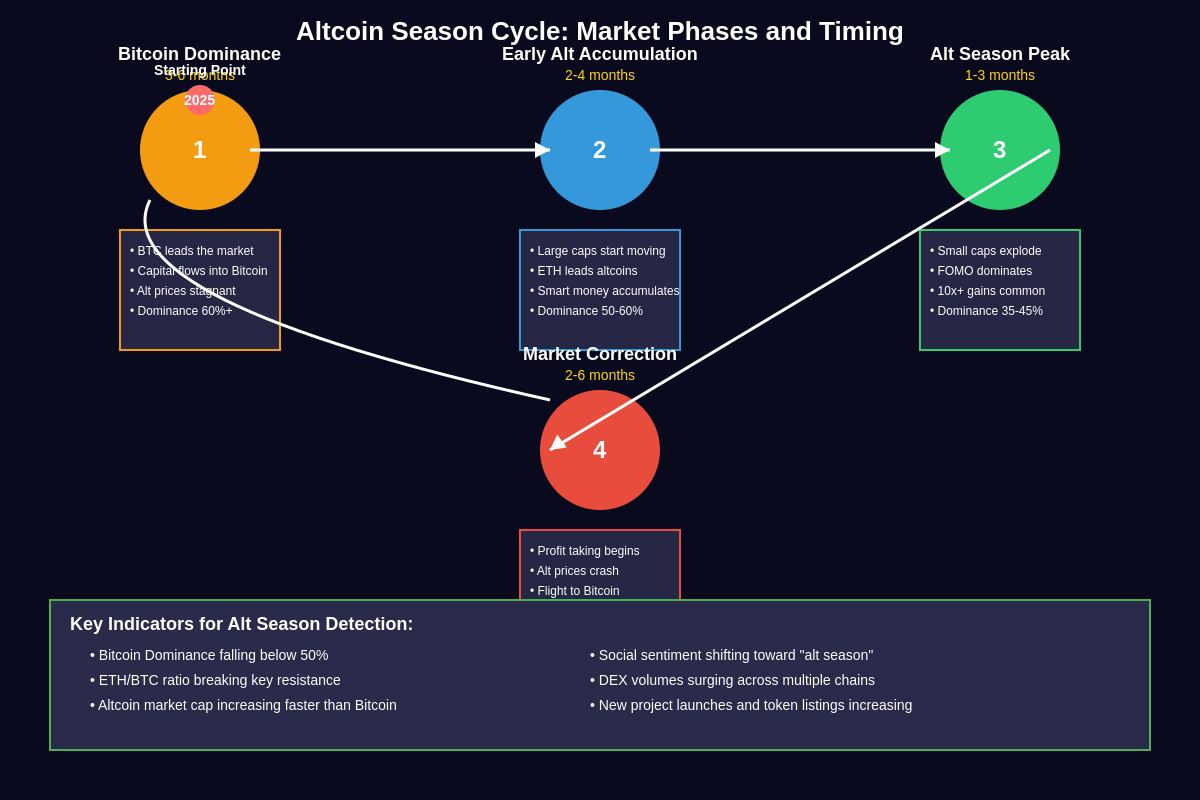
The Return of Altcoin Dominance
The cryptocurrency market stands at a pivotal moment as we enter 2025, with institutional adoption reaching unprecedented levels and regulatory clarity emerging across major jurisdictions. After Bitcoin’s remarkable surge throughout 2024, market dynamics are shifting toward what analysts believe could be the most significant altcoin season in crypto history. This cyclical pattern, where alternative cryptocurrencies dramatically outperform Bitcoin, has captured the attention of both retail and institutional investors seeking exponential returns in an increasingly mature digital asset ecosystem.
Historical precedent suggests that altcoin seasons typically follow periods of Bitcoin dominance, as capital flows from the leading cryptocurrency into smaller, more speculative alternatives. The 2017 and 2021 bull runs demonstrated this phenomenon spectacularly, with some altcoins delivering gains exceeding 10,000% during peak periods. However, the 2025 landscape presents unique characteristics that distinguish it from previous cycles, including enhanced institutional participation, clearer regulatory frameworks, and technological innovations that have fundamentally improved the utility and scalability of alternative blockchain platforms.
Market Cycle Analysis and Timing Indicators
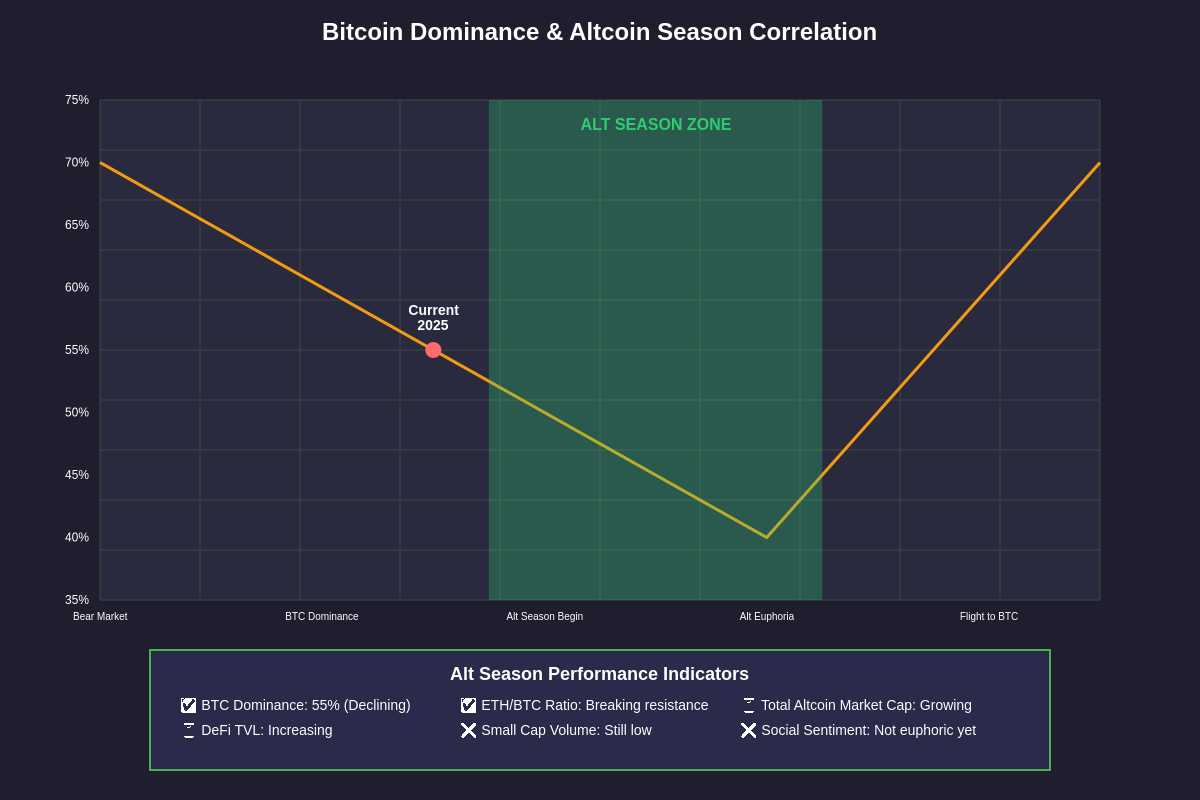
Understanding the mechanics of altcoin seasons requires deep analysis of market cycles and the psychological patterns that drive investor behavior. The current market structure exhibits several key indicators that historically precede major altcoin rallies, including Bitcoin dominance approaching critical resistance levels, increasing transaction volumes across decentralized exchanges, and growing institutional interest in alternative layer-1 blockchain platforms. Professional traders monitoring comprehensive crypto market data and dominance charts have identified several technical patterns suggesting an imminent shift toward alt-season dynamics.
The Bitcoin dominance index, which measures Bitcoin’s market capitalization relative to the total cryptocurrency market, currently hovers around levels that have historically marked the beginning of significant altcoin outperformance periods. When this metric begins declining from elevated levels, it typically signals capital rotation from Bitcoin into alternative cryptocurrencies, creating the momentum that drives exponential price appreciation across the broader digital asset ecosystem.
Market sentiment indicators also point toward growing optimism for alternative cryptocurrencies, with social media engagement, developer activity, and venture capital investment all showing increased focus on non-Bitcoin projects. The Fear and Greed Index, while still elevated due to Bitcoin’s performance, shows increasing interest in riskier assets as investors seek higher returns in an environment of growing institutional acceptance and mainstream adoption.
Layer-1 Blockchain Platforms Leading the Charge
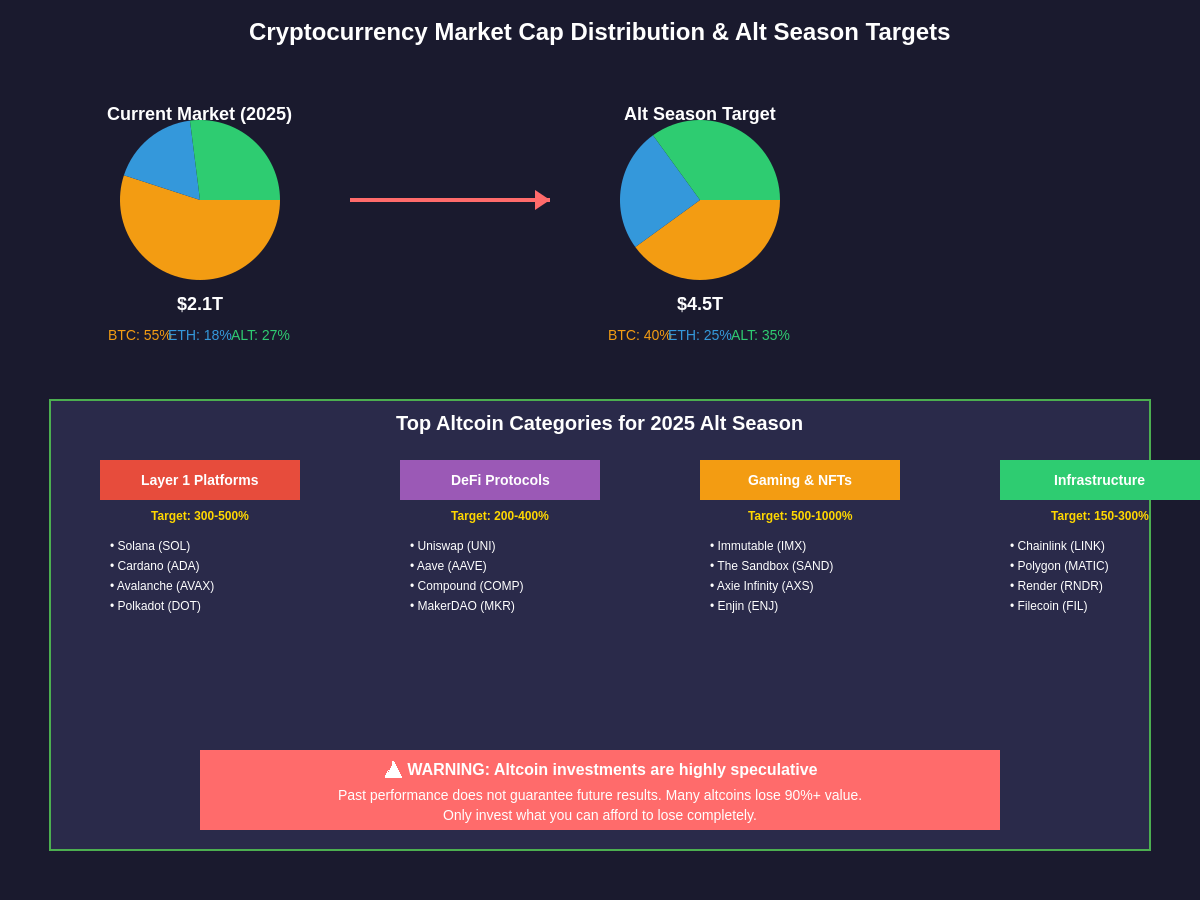
The foundation of the anticipated 2025 altcoin season rests heavily on the continued evolution and adoption of layer-1 blockchain platforms that offer improvements over earlier generations of cryptocurrency networks. Ethereum remains the dominant smart contract platform, but its ecosystem faces increasing competition from faster, more cost-effective alternatives that have gained significant developer mindshare and user adoption throughout 2024.
Solana has emerged as a formidable competitor to Ethereum, offering transaction speeds exceeding 50,000 transactions per second with minimal fees, making it an attractive platform for high-frequency trading applications, gaming, and NFT marketplaces. The network’s recovery from the FTX-related challenges of 2022 has been remarkable, with total value locked continuing to grow and major institutional players beginning to explore Solana-based applications. Investors tracking Solana’s price movements and technical patterns should monitor key resistance levels and volume indicators that could signal the beginning of a major breakout.
Cardano represents another compelling opportunity within the layer-1 category, with its research-driven approach to blockchain development finally beginning to translate into practical applications and ecosystem growth. The network’s focus on sustainability, academic rigor, and gradual feature rollouts has created a robust foundation for long-term growth, particularly as environmental concerns become increasingly important for institutional cryptocurrency adoption.
Avalanche has distinguished itself through its unique consensus mechanism and subnet architecture, enabling the creation of customized blockchain networks while maintaining interoperability with the broader Avalanche ecosystem. This technological flexibility has attracted numerous enterprise partnerships and DeFi protocols, positioning AVAX as a potential beneficiary of increased institutional blockchain adoption.
DeFi Innovation and Yield Generation Opportunities
Decentralized finance continues to evolve beyond simple token swapping and lending protocols, with 2025 expected to witness the maturation of more sophisticated financial instruments and yield generation strategies. The DeFi sector’s total value locked has stabilized after the volatility of previous years, creating a foundation for sustainable growth based on real utility rather than purely speculative interest.
Uniswap remains the dominant decentralized exchange protocol, but its token UNI represents more than just governance rights in an automated market maker. The protocol’s evolution toward more complex financial products, including perpetual contracts and options trading, positions it as a critical infrastructure component for the decentralized financial ecosystem. The upcoming implementation of Uniswap v4 with its hooks system could enable unprecedented customization and efficiency improvements.
Aave has established itself as the leading lending and borrowing protocol, with its innovative features like flash loans and credit delegation creating new possibilities for capital efficiency in DeFi. The protocol’s expansion into real-world assets and institutional lending products suggests significant growth potential as traditional finance continues to integrate with decentralized alternatives.
Compound Finance continues to pioneer new approaches to algorithmic interest rate determination and collateralized lending, with its governance token COMP serving as both a participation mechanism and a bet on the continued growth of decentralized lending markets. The protocol’s emphasis on security and gradual feature expansion has made it a preferred choice for risk-averse DeFi participants.
Gaming and Metaverse Token Ecosystems
The convergence of blockchain technology with gaming and virtual worlds represents one of the most promising areas for explosive growth during the anticipated 2025 altcoin season. Unlike previous speculative bubbles in gaming tokens, the current landscape is characterized by actual playable games with sustainable economic models and genuine entertainment value that extends beyond token price appreciation.
Immutable X has positioned itself as the leading layer-2 solution for NFT gaming, offering zero gas fees for trading and minting while maintaining the security of Ethereum’s main network. The platform’s partnerships with major gaming studios and its focus on user experience rather than complex tokenomics suggest strong potential for mainstream adoption. The IMX token serves multiple functions within the ecosystem, including staking, governance, and fee sharing, creating multiple value accrual mechanisms.
The Sandbox continues to expand its virtual world ecosystem, with major brands and celebrities establishing virtual presences within its metaverse environment. The SAND token functions as both currency and governance mechanism for this digital realm, with increasing utility as more experiences and games launch within the platform. The project’s focus on user-generated content and creator monetization aligns with broader trends toward decentralized content creation and ownership.
Axie Infinity, despite facing challenges in previous market cycles, has undergone significant development to address sustainability concerns and improve gameplay mechanics. The AXS token represents ownership in one of the most successful blockchain gaming ecosystems, with ongoing developments in land gameplay and economic rebalancing potentially catalyzing renewed interest.
AI and Data-Focused Cryptocurrency Projects
The intersection of artificial intelligence and blockchain technology has created new categories of cryptocurrency projects that could experience significant appreciation during the 2025 altcoin season. These tokens often combine the computational requirements of AI training with blockchain-based incentive mechanisms, creating novel economic models for distributed computing and data processing.
Render Network has emerged as a leading platform for distributed GPU rendering, serving both traditional graphics applications and AI training workloads. The RNDR token compensates users who contribute computing power to the network, creating a decentralized alternative to centralized cloud computing services. As AI development continues to require massive computational resources, platforms like Render could see exponential demand growth.
Ocean Protocol focuses on data sharing and monetization, providing tools for individuals and organizations to securely trade data while maintaining privacy and control. The OCEAN token facilitates these data transactions and governs protocol development, positioning it to benefit from increasing awareness of data rights and the growing AI training data market.
Fetch.ai combines artificial intelligence with blockchain technology to create autonomous economic agents that can perform tasks and negotiate on behalf of their users. The FET token powers this ecosystem of AI agents, with applications ranging from supply chain optimization to autonomous vehicle coordination. As AI integration becomes more prevalent across industries, projects like Fetch.ai could see substantial adoption growth.
Infrastructure and Interoperability Solutions
The maturation of the cryptocurrency ecosystem has highlighted the critical importance of infrastructure and interoperability solutions that enable seamless communication between different blockchain networks. These projects often experience significant value appreciation during altcoin seasons as they become essential components of the broader crypto economy.
Chainlink remains the dominant oracle network, providing reliable real-world data to smart contracts across multiple blockchain platforms. The LINK token secures the network through staking mechanisms and compensates node operators for providing accurate data feeds. As smart contracts become more sophisticated and require more diverse data sources, Chainlink’s utility and value proposition continue to strengthen. Market participants analyzing Chainlink’s technical indicators and price trends should focus on network adoption metrics and partnership announcements that drive fundamental value.
Polygon has established itself as the leading scaling solution for Ethereum, offering faster and cheaper transactions while maintaining compatibility with the Ethereum Virtual Machine. The MATIC token serves multiple purposes within the ecosystem, including transaction fees, staking, and governance participation. As Ethereum continues to face scalability challenges, layer-2 solutions like Polygon become increasingly valuable for applications requiring high throughput and low costs.
Polkadot’s unique approach to blockchain interoperability through its parachain architecture enables specialized blockchains to communicate and share security while maintaining their individual characteristics. The DOT token facilitates governance, staking, and parachain slot auctions, creating multiple mechanisms for value accrual as the ecosystem expands and more projects launch parachains.
Privacy and Security-Focused Cryptocurrencies
Growing concerns about digital privacy and financial surveillance have renewed interest in cryptocurrencies that prioritize anonymity and security features. While regulatory scrutiny remains a challenge for privacy coins, technological improvements and changing geopolitical dynamics could drive significant adoption during the 2025 altcoin season.
Monero continues to lead the privacy coin category with its robust ring signature technology and mandatory privacy features that make transaction analysis extremely difficult. The XMR token serves as digital cash with fungibility and privacy characteristics that more closely resemble physical currency than transparent blockchain alternatives. Increasing government overreach and digital surveillance concerns could drive substantial demand for privacy-preserving cryptocurrencies.
Zcash offers optional privacy features through its zero-knowledge proof technology, enabling users to choose between transparent and shielded transactions based on their privacy requirements. The ZEC token benefits from ongoing development in zero-knowledge cryptography while maintaining compliance capabilities that could appeal to institutional users requiring both privacy and auditability.
Secret Network provides privacy-preserving smart contracts through its unique approach to confidential computing on blockchain networks. The SCRT token secures the network and enables governance participation in what could become essential infrastructure for applications requiring confidential data processing while maintaining blockchain transparency and verifiability.
Emerging Trends and Narrative-Driven Opportunities
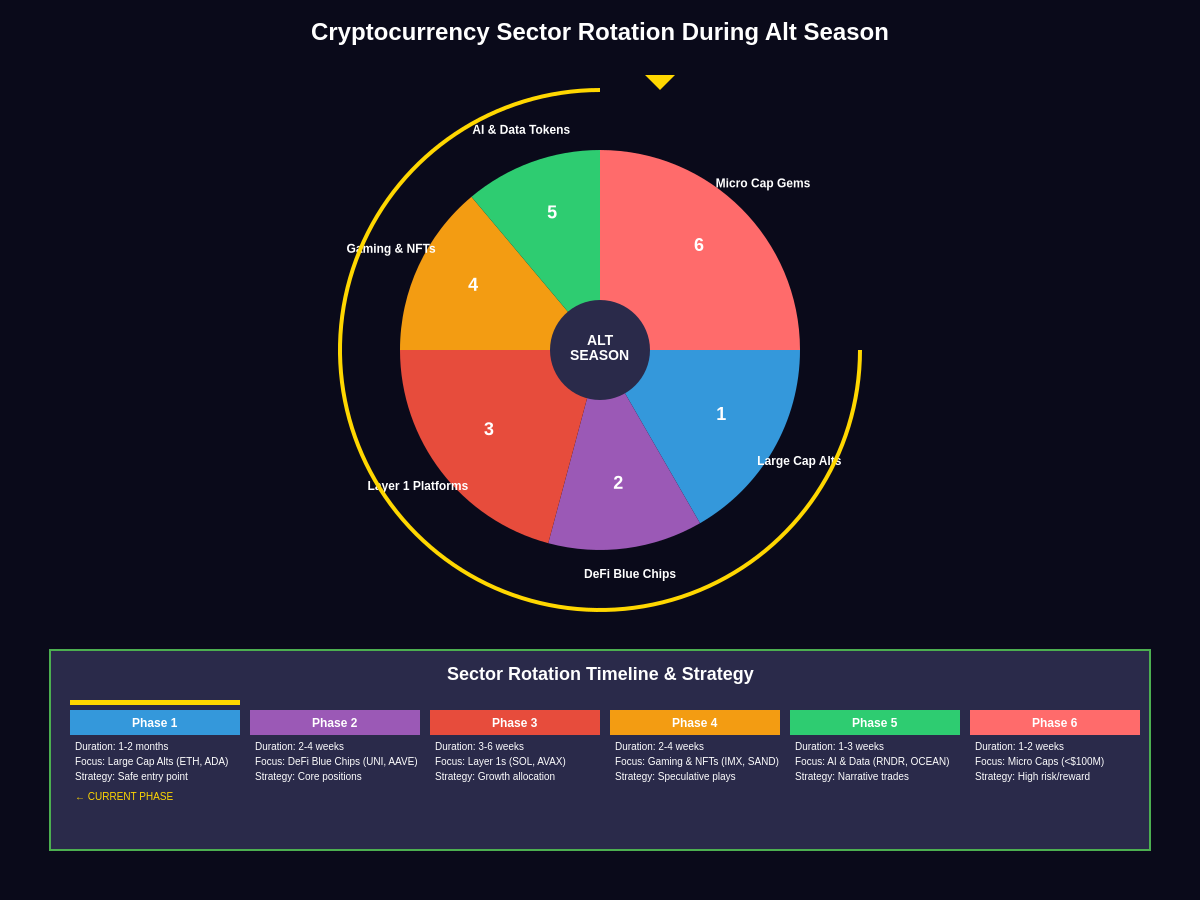
Successful altcoin season investing often requires identifying and positioning early in emerging trends and narratives that capture market attention and investment flows. The 2025 landscape presents several developing themes that could generate substantial returns for early adopters who correctly identify and time their exposure to relevant projects.
Real World Asset (RWA) tokenization has gained significant momentum as traditional financial institutions explore blockchain-based alternatives to conventional asset management and trading systems. Projects focusing on tokenizing real estate, commodities, and financial instruments could experience substantial growth as regulatory frameworks clarify and institutional adoption accelerates.
Carbon credit and environmental impact tracking represents another emerging narrative, with blockchain projects developing solutions for carbon market transparency, renewable energy trading, and sustainability verification. As environmental, social, and governance (ESG) concerns become increasingly important for institutional investors, cryptocurrencies addressing these issues could see significant capital inflows.
Decentralized Physical Infrastructure Networks (DePIN) combine blockchain incentives with real-world infrastructure deployment, creating token economies around wireless networks, storage systems, and computing resources. These projects often require significant initial investment but can generate substantial returns as their physical networks achieve scale and utility.
Risk Management and Portfolio Construction Strategies
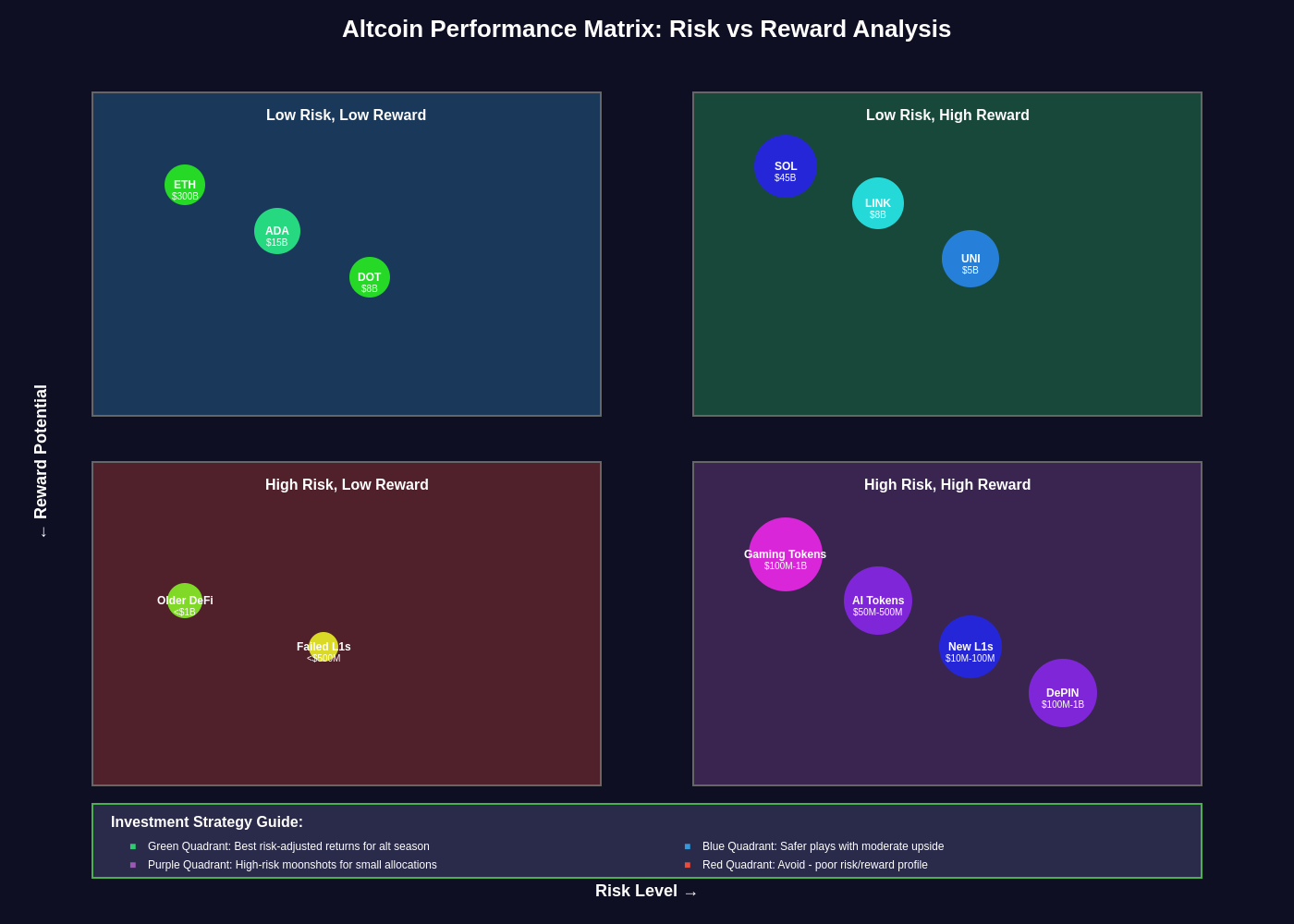
Participating in altcoin season opportunities requires sophisticated risk management approaches that account for the extreme volatility and speculative nature of alternative cryptocurrency investments. Professional portfolio construction techniques become essential for maximizing returns while protecting capital during inevitable market corrections and periods of reduced sentiment.
Position sizing represents the most critical component of altcoin investment strategy, with experienced traders typically allocating smaller percentages of their portfolios to higher-risk, higher-reward alternative cryptocurrencies. The potential for 10x or 100x returns must be balanced against the equally possible scenario of total loss, requiring position sizes that enable participation in potential upside while limiting downside exposure to acceptable levels.
Diversification across different categories of altcoins can help reduce correlation risk while maintaining exposure to various growth narratives and trends. A well-constructed altcoin portfolio might include layer-1 platforms, DeFi protocols, gaming tokens, infrastructure projects, and emerging trend plays, with weightings adjusted based on risk tolerance and market conditions.
Timing considerations become crucial during altcoin seasons, as these market phases often exhibit rapid acceleration followed by equally dramatic reversals. Technical analysis tools and on-chain metrics can provide valuable insights for entry and exit timing, though the speculative nature of many alternative cryptocurrencies makes fundamental analysis equally important for long-term positioning.
Technical Analysis and Market Timing Considerations
The cyclical nature of cryptocurrency markets creates opportunities for technical analysis to provide valuable insights into optimal timing for altcoin investments. Historical patterns suggest that altcoin seasons follow predictable phases, beginning with gradual accumulation, accelerating through discovery and momentum phases, and concluding with euphoric peaks followed by substantial corrections.
Bitcoin dominance charts serve as primary timing indicators for altcoin season phases, with declining dominance typically coinciding with the beginning of alt-season momentum. When Bitcoin’s market share falls below critical technical levels, capital rotation into alternative cryptocurrencies often accelerates rapidly, creating the conditions for exponential price appreciation across the broader altcoin market.
Volume analysis becomes particularly important during altcoin seasons, as increased trading activity often precedes significant price movements. Projects experiencing unusual volume spikes combined with positive fundamental developments frequently become leaders during alt-season rallies. Advanced traders utilize sophisticated charting and technical analysis tools to identify these early accumulation phases and position accordingly before broader market recognition drives prices substantially higher.
On-chain metrics provide additional context for timing altcoin investments, with indicators such as active addresses, transaction volumes, and developer activity offering insights into fundamental adoption trends that support sustained price appreciation. Projects showing consistent growth in these metrics often outperform during altcoin seasons, as improved fundamentals attract both retail and institutional investment flows.
Regulatory Environment and Institutional Adoption Impact
The 2025 altcoin season unfolds within a significantly different regulatory environment compared to previous cycles, with clearer guidelines emerging from major jurisdictions and increasing institutional participation in alternative cryptocurrency markets. These developments create both opportunities and challenges for altcoin investors, as regulatory clarity reduces uncertainty while potentially limiting the explosive growth potential that characterized earlier, less regulated market cycles.
United States regulatory developments, particularly regarding digital asset classification and trading regulations, continue to influence global cryptocurrency markets and investor sentiment. Projects with clear regulatory compliance strategies and transparent development teams often attract institutional capital more readily, potentially creating sustained demand during altcoin season rallies.
European Union regulations, including the Markets in Crypto-Assets (MiCA) framework, provide additional clarity for cryptocurrency operations within European markets. Alternative cryptocurrencies that proactively address regulatory requirements often experience reduced volatility and more stable institutional adoption, though this compliance focus may moderate explosive growth potential.
Institutional adoption patterns suggest growing sophistication in alternative cryptocurrency selection, with professional investors increasingly focusing on projects with clear utility, sustainable tokenomics, and experienced development teams rather than purely speculative investments. This trend could result in more sustainable altcoin season dynamics with less extreme volatility but potentially longer-lasting appreciation cycles.
Global Economic Factors and Macro Environment Influence
The macroeconomic environment significantly influences cryptocurrency market cycles, with factors such as interest rates, inflation expectations, and currency debasement affecting both Bitcoin and altcoin performance. The 2025 landscape presents unique macroeconomic conditions that could amplify altcoin season dynamics while creating new risk considerations for investors.
Central bank digital currency (CBDC) developments continue to influence cryptocurrency adoption patterns, with some viewing government digital currencies as validation of blockchain technology while others see them as potential competition for decentralized alternatives. The interaction between CBDCs and existing cryptocurrencies could create new opportunities for privacy-focused and decentralized alternative cryptocurrencies.
Geopolitical tensions and currency instability often drive increased cryptocurrency adoption in affected regions, potentially creating sustained demand for alternative cryptocurrencies that offer features not available in traditional financial systems. Projects focusing on cross-border payments, store of value characteristics, or financial sovereignty could benefit from these trends.
Global economic uncertainty typically increases investor interest in alternative assets, including cryptocurrencies, as traditional investment options become less attractive or accessible. This trend could support extended altcoin season dynamics as investors seek diversification and potential high returns in an uncertain economic environment.
Future Outlook and Long-Term Considerations
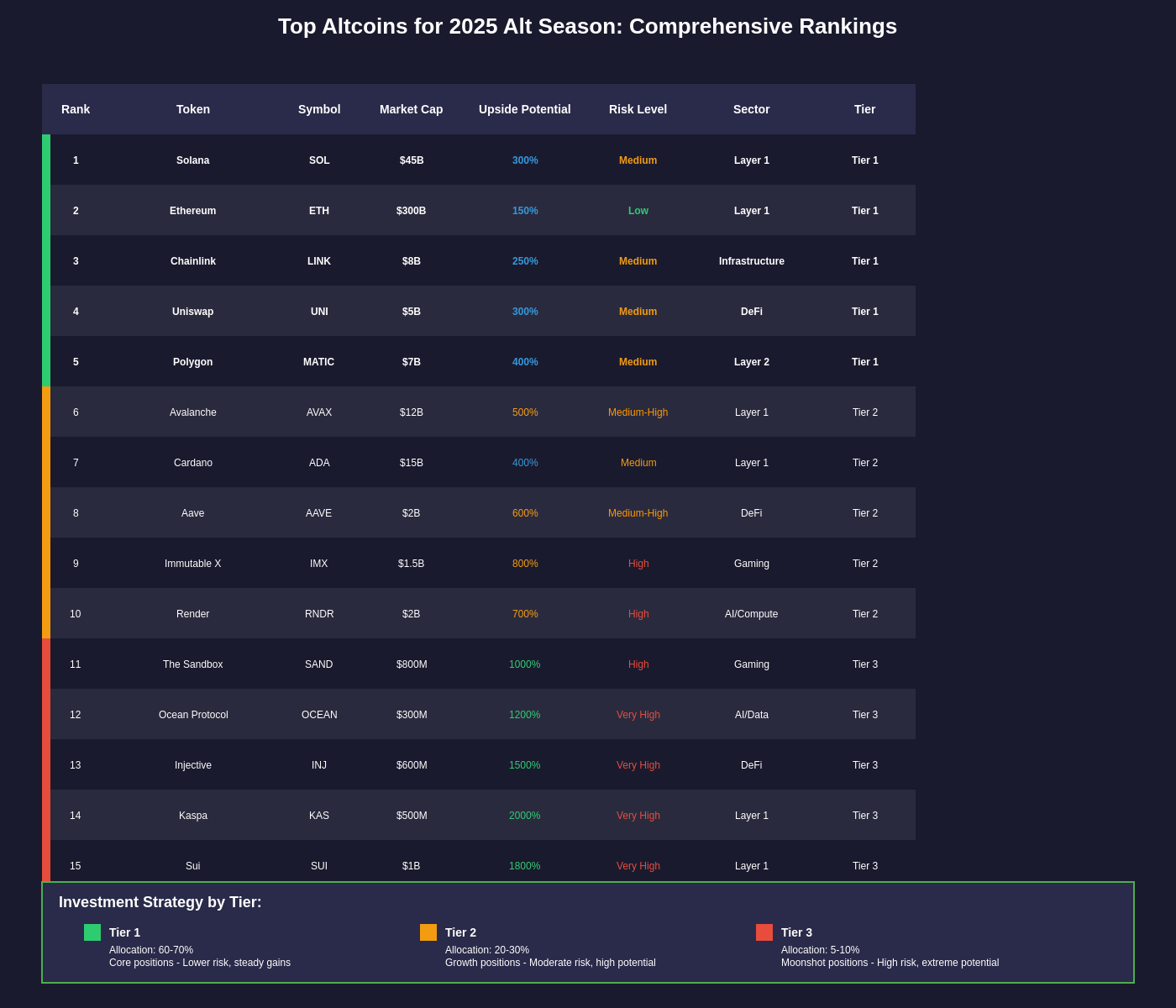
While altcoin seasons typically represent relatively short periods of intense speculation and price appreciation, the underlying technological and adoption trends driving the 2025 cycle suggest potential for more sustained growth in alternative cryptocurrency markets. The maturation of blockchain infrastructure, increasing real-world utility, and growing institutional acceptance create fundamentally different conditions compared to previous speculative cycles.
The integration of artificial intelligence, Internet of Things (IoT) devices, and blockchain technology creates new categories of cryptocurrency applications that extend far beyond simple digital currencies or speculative trading instruments. Projects successfully implementing these technological convergences could experience sustained growth that extends well beyond traditional altcoin season timeframes.
Demographic shifts, particularly increasing cryptocurrency adoption among younger generations who view digital assets as natural components of modern financial systems, suggest long-term structural demand growth for alternative cryptocurrencies. This generational transition could provide sustained support for altcoin valuations even after speculative excitement subsides.
Environmental and sustainability considerations continue to influence cryptocurrency development and adoption patterns, with projects addressing these concerns potentially benefiting from long-term trend tailwinds. As climate change and environmental responsibility become increasingly important for all industries, cryptocurrencies offering sustainable alternatives to energy-intensive consensus mechanisms could experience sustained institutional adoption.
The 2025 altcoin season represents both tremendous opportunity and significant risk for cryptocurrency investors willing to navigate the complex landscape of alternative digital assets. Success requires careful research, sophisticated risk management, and the ability to identify genuine technological innovation among the numerous speculative projects competing for attention and capital. Professional investors utilize comprehensive market analysis and risk assessment tools to evaluate potential opportunities while maintaining appropriate diversification and position sizing to participate in potential exponential returns while protecting against inevitable market corrections and periods of reduced sentiment.
Disclaimer: This article is for educational and informational purposes only and should not be construed as financial advice. Cryptocurrency investments carry significant risks, including the potential for total loss of capital. Altcoin investments are particularly speculative and volatile, with many projects failing to deliver on their promises. Past performance does not guarantee future results, and the cryptocurrency market remains highly unpredictable. Always conduct your own research and consult with qualified financial advisors before making investment decisions. The author and publisher are not responsible for any financial losses that may occur from acting on the information provided in this article.